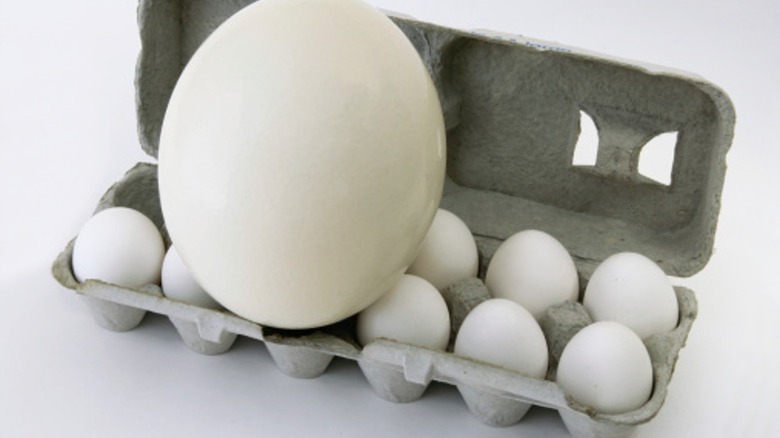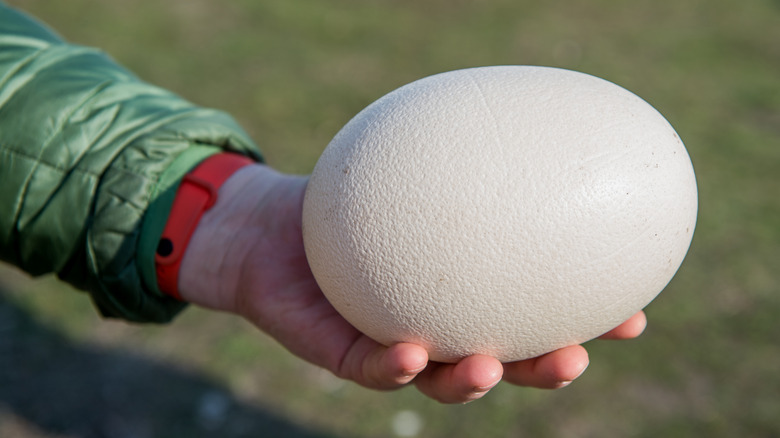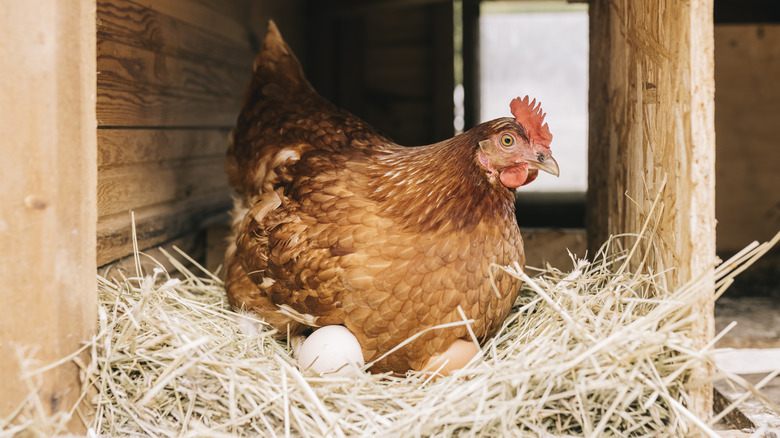How Ostrich Eggs Compare To The Chicken Version
When a recipe calls for eggs, 99.99% of the time it's probably safe to assume that the kind that comes from a chicken is what's intended unless otherwise specified. All species of birds lay eggs, though, as well as non-birds such as frogs, turtles, and platypi, and quite a few of these eggs are edible. Fish eggs, in fact, are a particularly pricey gourmet goodie when called by the name of caviar. Even if we stick with bird eggs alone, quail, duck, and even emu eggs have their place in the culinary pantheon. As, of course, do ostrich eggs, or why else would we be writing about them on a food site?
Perhaps the most notable thing about an ostrich egg is its size. These outsize ovoids are equivalent to about 24 chicken eggs, so they may come in handy for baking if you plan to make cakes or cookies for a crowd. One such egg could also be used as the basis for a giant food challenge if you fried it up and accompanied it with a couple of pounds of bacon or sausage and an entire loaf of toast. (A British restaurant tried something along these lines a few years back, although admittedly it did advertise the dish as serving four to six diners.)
Ostrich eggs may not taste much different than chicken eggs
Even though an ostrich egg is pretty large, relative to chicken eggs, it is also pretty expensive. Assuming you can even find one to purchase, the price per egg may start around $30 and go up as high as $100, which is considerably more than two dozen eggs cost even back when the prices were soaring in a way unbefitting a flightless bird. The main reason to buy an ostrich egg is most likely the novelty factor as by all accounts they don't taste too much different than chicken eggs. A woman in one YouTube video featured says they taste like slightly more flavorful chicken eggs, while a vendor called the Exotic Meat Market describes them as buttery and sweet. Chicago chef Justin White, however, finds ostrich egg yolks to be gamy, sulfurous, and somewhat unpleasant. Luckily for White, ostrich eggs tend to have a higher ratio of white to yolk than do chicken eggs.
An ostrich egg that weighs 3 pounds (1400 grams) has about 2000 calories, 176 grams of protein,133 grams of fat (44 of which is saturated), and 5208 milligrams of cholesterol. If we assume that an ostrich egg = 24 servings, then a single serving would have 83 calories, 14.6 grams of protein, 11 grams of fat (3.6 saturated), and 434 milligrams of cholesterol.
Chicken eggs are easier to cook
Chicken eggs, while similar to ostrich eggs, do have a slightly different nutritional profile. Each large egg has approximately 72 calories and 6.3 grams of protein along with 4.8 grams of fat (1.6 saturated) and 186 milligrams of cholesterol. Both types of eggs are roughly equal when it comes to the amounts of calcium, phosphorus, riboflavin, and thiamine they provide, but chicken eggs may have more Vitamins A and E, manganese, and zinc although slightly lower amounts of iron and magnesium.
The main advantage that chicken eggs have over ostrich ones, though, apart from affordability and availability, lies in the fact that they are much easier to crack and cook. An ostrich egg might require a hammer to break into, although some may prefer to use a drill since the thick shell can be painted or dyed to make a great Easter decoration. If you want to cook the egg in its shell, it can take up to 2 hours to hard boil. Even then, the final product won't be your best choice for making deviled eggs if Justin White's experience is anything to go by. As he relates to Chicago Reader, the one time he tried boiling an ostrich egg, the soft and jelly-like white collapsed under its own weight as soon as he cut into it. While he was able to salvage the non-devilable egg by using it in a salad, he says he has no plans to use this ingredient again.


